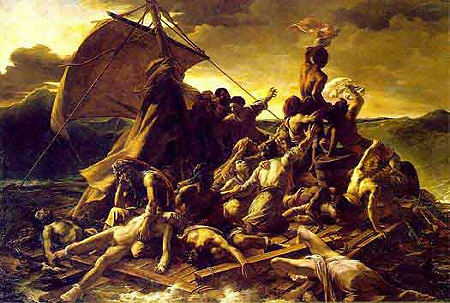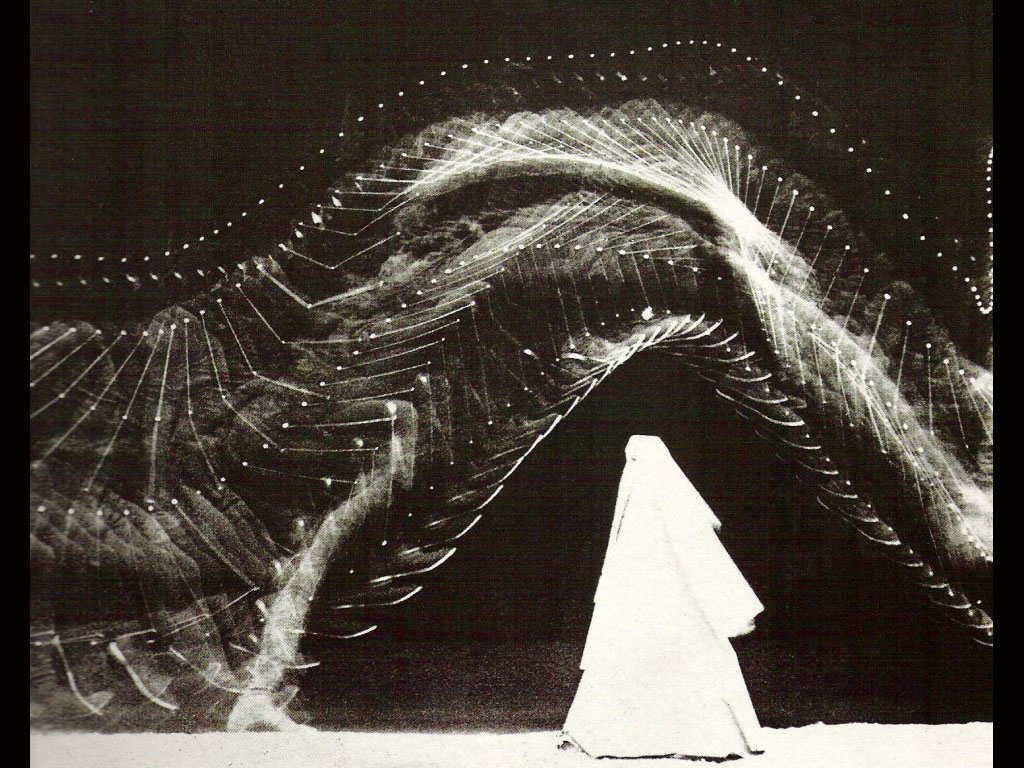
Since the mid-1980s, Walter Benn Michaels has been one of Michael Fried's biggest backers and most interesting interpreters. Yet, in a humdinger of a critical article from early 2011, Michaels lumps Fried and Jacques Rancière in with what he calls "neoliberal aesthetics." Is he serious? Is this all just some storm in a teacup drummed up to stir the pot, as it were? And what would does Michaels mean with that label anyway?
Let's back the boat up for a moment to the most interesting bits of Rancière's Notes on the Photographic Image, a piece singled out for scrutiny by Michaels. Rancière introduces a meditation on Hegel's reading of Bartolome Esteban Murillo's Two Boys Eating Grapes and Melon (oil on canvas, ca. 1645; Alte Pinakothe, Munich), which we see at left. Hegel, Rancière reminds us, had called attention to the "carefree" attitude of Murillo's boys; they seem to possess such brio and nonchalance that they transfigure both the generic type of the picture and the low social class into which they would have been categorize by the elites of the ancien régime who commissioned such pictures. The boys' unexpected self-possession—this "suspension of the opposition beween activity and passivity" (14)—marks an important departure from the alienation of the beholder from the image that Rancière sees as the legacy of Michael Fried's absoprtive tradition. "Presenting the characters in the scene as completely absorbed by their task is, for him," Rancière writes, "the means by which the painters of that period ... posed and resolved the big question of artistic modernity: how can a work be made coherent by excluding the spectator from its space?" (14)
Let's back the boat up for a moment to the most interesting bits of Rancière's Notes on the Photographic Image, a piece singled out for scrutiny by Michaels. Rancière introduces a meditation on Hegel's reading of Bartolome Esteban Murillo's Two Boys Eating Grapes and Melon (oil on canvas, ca. 1645; Alte Pinakothe, Munich), which we see at left. Hegel, Rancière reminds us, had called attention to the "carefree" attitude of Murillo's boys; they seem to possess such brio and nonchalance that they transfigure both the generic type of the picture and the low social class into which they would have been categorize by the elites of the ancien régime who commissioned such pictures. The boys' unexpected self-possession—this "suspension of the opposition beween activity and passivity" (14)—marks an important departure from the alienation of the beholder from the image that Rancière sees as the legacy of Michael Fried's absoprtive tradition. "Presenting the characters in the scene as completely absorbed by their task is, for him," Rancière writes, "the means by which the painters of that period ... posed and resolved the big question of artistic modernity: how can a work be made coherent by excluding the spectator from its space?" (14)
Defining and defending the "fourth wall" of the picture-plane, painters of absorptive pictures were not simply attempting to compel visual attention by making their figures appear to flee in horror from the beholder's ambit—as Fried famously proposed of Gericault's Raft of the Medusa in Absorption and Theatricality. Instead, by Rancière's account, they were simultaneously imposing a conception of art as a disciplining mechanism, policing life inside and beyond the image. The logic of absorption, he contends, runs this way: "The active absorption of characters by their task is, ultimately, only their passive absorption into the space of the painting. What they are or do matters little, but what is important is that they are put in their place." (14) What he is proposing, I think, is a conception whereby art is made—or, art registers—the resistance between the aesthetic aims of the image-maker and the subject being depicted.
And photography is privileged medium for this kind of confrontation as artist and non-art (photographic subjects) stare each other down so repeatedly in it. Thus, what we see when Walker Evans makes a pictorial masterpiece by photographing the kitchens of poor farmers in 1930s America is not only his compositional genius: "it is the correlate ability acquired by the characters themselves [that is, the poor farmers] to play with the image of their own being and of their condition, to post it to walls or to set it up before the lens." (15) Photographed subjects matter, Rancière claims; they help make the art. Far from being the extension of the modern tradition that puts beholders in their place by systematically excluding them, then, photography is "the bearer of this tendency to break the [alienating] historical complicity between the art of the photographer and the aesthetic capacity of his subjects." (15)
Fair enough, one might be tempted to say, but how does this have any bearing on neoliberalism? By what means can we draw connections between Rancière's conception of the photograph and a globally-diffused economic ideology privileging "privatization, deregulation, and financial and trade liberalization" (8) backed by the strong military force of an otherwise weak state, as one recent analysis defines neoliberalism? Yet, these are the connection for which Walter Benn Michaels tries to argue in a typically gnarly article. Taking up the kind of low-genre picture lionized by Rancière, Michaels begins with the seemingly innocuous question of why Diderot didn't like still life painting according to Fried. Rehearsing arguments from Absorption and Theatricality, Fried's Diderot appears either unmoved by the lack of difficulty in convincing the beholder that his/her presence had been effectively negated before a still life or, paradoxically, irritated by the theatricality that comes with the inevitable recognition that the painter must have set up this arrangement only to make a picture that would deny the beholder's presence. (2) For Michaels, this paradoxical demand "that the painter be as unconcerned with producing an effect on the beholder as the young girl reading [in the painting he has made] is" (2) has less to do with Diderot than with the post-modern present. In our times, it defines "an antimony—the works of art we value are those which seek to produce no effect on the beholder, but without the effort to produce an effect on the beholder (without the effort, as we might say, to make something that can be seen), there would be no works of art." (2)
Often conceived as split between nature and culture, man and machine, intent and accident, photography's great contemporary allure -- and especially that of Roland Barthes's concept of the punctum, the incidental photographic feature that idiosyncratically "wounds" a beholder by accident -- is that it offers a means of addressing the contradictory demands of this antimony in one coup. The fact that photography "characteristically displays images over which the photographer does not have complete control and thus makes it possible to value just those images (the punctum) means that what the photographer has tried to do ... may have nothing to do with the beauty, value or meaning of the photograph. The difficulty of imagining an artist who isn't trying to create a work of art is resolved by imagining instead an artist whose efforts to create the work are irrelevant to its meaning." (3-4) But, by arrogating Barthes and the punctum's unknowable effects into his absorptive tradition, Fried has made for himself some truly unholy alliances. "Probably no one would think to call John Cage an absorptive artist" (5), Michaels quips with wry understatement, before provocatively narrating the structuring parallels between Barthes's anti-intentional, "death of the author/birth of the reader" model of textuality and Cage's refusal to dictate to musicians and audience in pieces like 4'33", which leave composition to sonic concatenations of chance.
With the connection to Rancière's arguments now shifting into view, Michaels summarizes the position this way: "4'33" can thus be understood as an exemplary case of the way in which a radicalized absorption—produced by the commitment to not impose one's intentions on the listener/beholder/reader, to not perform for an audience—becomes indistinguishable from an account of the work of art in which it is theatricality that's radicalized—the only thing that matters is the audience's response." (6) Where Rancière had viewed photography as exemplary of art's fundamental co-production between artist and subject, Michaels sees resolution to the paradoxical demand that the effective work can't be intentionally made to work effects in the erasure of boundaries between work and beholder's experience of it—the very theatrical condition that Fried had abhorred in Minimalism!
With the connection to Rancière's arguments now shifting into view, Michaels summarizes the position this way: "4'33" can thus be understood as an exemplary case of the way in which a radicalized absorption—produced by the commitment to not impose one's intentions on the listener/beholder/reader, to not perform for an audience—becomes indistinguishable from an account of the work of art in which it is theatricality that's radicalized—the only thing that matters is the audience's response." (6) Where Rancière had viewed photography as exemplary of art's fundamental co-production between artist and subject, Michaels sees resolution to the paradoxical demand that the effective work can't be intentionally made to work effects in the erasure of boundaries between work and beholder's experience of it—the very theatrical condition that Fried had abhorred in Minimalism!
All of this, we might imagine, could make Rancière very happy as his is a critique Fried's view of art. Yet, Michaels then turns the argument another way. Just as it is specious to massage the definition of effective art into that which has to be made free from the intent to produce effects, it is even more misguided to try to claim that embracing a view of art that ennobles to co-producer its degraded, down-trodden subjects thereby empowers them. The differences from the modernist tradition of, say, James Agee and Walker Evans are here stark: "Where for Rancière ... photographs are an occasion for the peasants to assert their aesthetic capacities, for Agee they are a kind of demonstration of what it is to be so 'appallingly damaged' that you no longer have any such capacities ... The crucial difference here is just the difference between seeing the beggar boys and peasants as damaged by our falsely hierarchical vision of them and seeing them as damaged by conditions that our vision may sanction or critique but that it did not produce." (12) Capitalist economics and not elitist "ways of seeing" have produced the misery depicted in these scenes and it is a piece of romanticizing clap-trap, Michaels claims to imagine that a theory of photography that gives agency to the represented dispossessed does anything to alter their dispossession.
 What, though, is the connection between the crisis of confidence of Fried's absorptive object and Rancière's identity politics? According to Michaels, they are knitted together by the massive increase of economic inequality resulting from neoliberal policies of the post-War era. A neoliberal problematic thus informs:
What, though, is the connection between the crisis of confidence of Fried's absorptive object and Rancière's identity politics? According to Michaels, they are knitted together by the massive increase of economic inequality resulting from neoliberal policies of the post-War era. A neoliberal problematic thus informs:
"the relation between both the rise in economic inequality and the hegemony of anti-discrimination[,] on the hand[,] and the crisis of absorption and the emergence of a theory of the work of art which, imagining the escape from the artist's intention, insists on the primacy of the beholder and (especially in the photograph) of the subject, on the other. If, in other words, Rancière is right to see a certain egalitarian ambition in a photography that seeks to embrace its 'poverty' ... it's an egalitarianism of a very particular kind—the kind that's critical of hierarchies of vision but has no purchase on the hierarchies embodied in rising Gini coefficients and the redistribution of wealth upwards that is at the heart of neoliberalism. The political meaning of the refusal of form (the political meaning of the critique of the works's 'coherence') is the indifference to those social structures that, not produced by how we see, cannot be overcome by seeing differently. It's this refusal of form that is thus as [surely, should be "at"] the heart of neoliberal aesthetics." (15)
So, whereas Rancière's beef with Fried is for being to much of an elitist modernist whose absorptive tradition wants to keep the great unwashed out and put them in their place, Michaels's Fried is not enough of a modernist—who gives up on intentional form to quickly and capitulates to postures of identity politics that have been fellow travelers with a period of unprecedented accumulation of capital in the hands of the wealthy. Michaels fleshes this last point out instructively at the end of the article: "The crisis in absorption produced an aesthetics that proved to be deeply compatible with the changes in capitalism which ... emerged politically in the late 70s and have flourished ever since. At the heart of these changes was a commitment to the importance of efficient markets and an egalitarianism defined as equality of access to those markets. ... Thus the emergence of a theory of the work of art ... as offering above all the opportunity to see and be seen differently has its political role to play, simultaneously advertising the attractions of neoliberal equality and serving as its good conscience." (19)
So, whereas Rancière's beef with Fried is for being to much of an elitist modernist whose absorptive tradition wants to keep the great unwashed out and put them in their place, Michaels's Fried is not enough of a modernist—who gives up on intentional form to quickly and capitulates to postures of identity politics that have been fellow travelers with a period of unprecedented accumulation of capital in the hands of the wealthy. Michaels fleshes this last point out instructively at the end of the article: "The crisis in absorption produced an aesthetics that proved to be deeply compatible with the changes in capitalism which ... emerged politically in the late 70s and have flourished ever since. At the heart of these changes was a commitment to the importance of efficient markets and an egalitarianism defined as equality of access to those markets. ... Thus the emergence of a theory of the work of art ... as offering above all the opportunity to see and be seen differently has its political role to play, simultaneously advertising the attractions of neoliberal equality and serving as its good conscience." (19)
Before I go back to read the portions of Fried's work on photography most under scrutiny here, I want to jot down the following question, which came to mind while re-reading this material. That is, the confusion of art and nature to which Michaels refers (6-10)—the demand that art aspires to the "condition of nature" whereby it seems to be formed without a purpose or intention—and the "perfect equilibrium" (13) between art and non-art to which Rancìere appeals ... all of these (often directly) betray debts to the aesthetics of Kant. Kant is more or less contemporaneous with Fried's hero, Diderot. But, he is also coeval with the prophets of economic liberalism like, say, Adam Smith. So, if Reaganism/Thatcherism produce the neoliberal conditions for the rebirth of this Kantian problematic, did Smith's classical liberalism in the late eighteenth century similarly produce the conditions for a Kantian aesthetics—or even for the emergence of the Diderotioan absorptive legacy itself?




